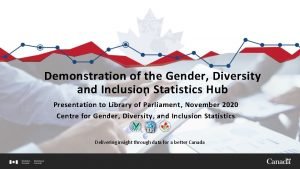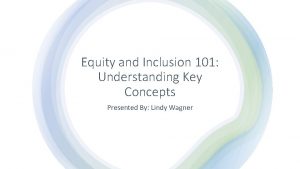Centre for Gender Diversity and Inclusion Statistics Disaggregated








- Slides: 8

Centre for Gender, Diversity and Inclusion Statistics: Disaggregated data for population groups and COVID-19 June 22, 2020 Delivering insight through data for a better Canada

Centre for Gender, Diversity and Inclusion Statistics Reporting to Canadians • Data Hub • GRF indicators • Analytical articles and infographics Generating new information • Advanced methodology • Standardized measures • Innovative use of data Building statistical capacity • Knowledge centre • Deliver GBA+ training 2 Delivering insight through data for a better Canada

Life expectancy by country, 2017 Health conditions in Canada prior to the COVID-19 pandemic 85 83 82 81 80 79 78 la nd ly itz er Ita Sw da na Ca nd la ria Ze a st w Au Ne St at es OE CD -T ot al Ge rm an y De nm Un ite ar k d Ki ng do m Gr ee ce Be lgi um d ey 77 rk • 84 Tu • • Canadians enjoy high life expectancy (LE) – 84. 1 years among women and 79. 9 years among men Over 60% report their health as very good to excellent Canadians can generally access the care they require – less than 10% report experiencing an unmet healthcare need On average, Canadians rate their life satisfaction as 8. 1 out of 10 – higher than the OECD average (7. 3) Un ite • But challenges remain…. Source: OECD Health Status (database), • Gaps in health among vulnerable populations including Indigenous peoples and those living with low income • First Nations women can expect to live 9 years less than non-Indigenous women • Men in the lowest income group can expect to live 7. 7 years less than men in the highest income group • The opioid crisis has claimed 14, 700 lives between Jan 2016 - September 2019, halting the growth in LE for the first time in four decades • One in ten Canadians has mood disorder such as depression • Approximately 44% of Canadian adults (aged 20+) live with one of 10 common chronic conditions such as hypertension and diabetes • An aging population will continue to put pressure on the need for healthcare, home and long-term care services - by 2041, 23. 6% or 10. 9 million people will be 65+ years of age; 4. 5% or 2. 1 million people will be 85+ years • Health system capacity varies - higher than OECD average for nurses (10 vs 8. 8 per 1, 000); less physician capacity (2. 5 vs 3. 5 per 1, 000 3 pop); lowest acute care bed capacity (2. 0 vs 3. 7 per 1, 000) but higher intensive care beds (12. 9 vs 12. 0 per 100, 000) Delivering insight through data for a better Canada

First Nations, Inuit and Metis people are among the vulnerable in terms of the direct health impacts of COVID-19 • 61% of Indigenous population lives in population centres and 39% in rural areas • • 73% of Inuit live in Inuit Nunangat • 44% of First Nations people with Registered or Treaty Indian status on reserve Limited health care access – • 82% of Inuit in Inuit Nunangat without a regular doctor • 19% of Indigenous people in urban areas without a regular doctor Proportion of First Nations people, Métis, and Inuit Living in Crowded Housing, Canada, 2016 Proportion of First Nations people 50+ years of age living off reserve, Métis and Inuit with selected pre-existing health conditions, by age group, 2017 60 50 Percent Heart disease Chronic bronchitis, emphysema or COPD Diabetes 30 20 10 High blood pressure 0 0 Inuit 40 Métis 5 10 15 20 25 First Nations people living off reserve Source: Aboriginal Peoples Survey, 2017 30 35 40 First Nations Living On Reserve Off Reserve One bedroom shortfall Métis Inside Inuit Nunangat Two or more bedroom shortfall Outside Inuit Nunangat 4 Source: Statistics Canada, Census of Population 2016 Delivering insight through data for a better Canada

Certain groups are more vulnerable to experiencing homelessness, placing them at higher risk for COVID-19 • In 2016, there were 995 shelters with a population of 22, 190 usual residents • this population grew by about 13% between 2006 and 2016 • Shelter residents were more likely to be … • Male - 60. 8% vs 49. 2% of the population living in private dwellings; and • unattached individuals when compared to the population in private dwellings • Certain sub-populations are more apt to experience homelessness – youth, Indigenous Peoples, women and families • Higher rates of mental illness, addictions and disability within the homeless population • While this is an at risk population for COVID-19 - official statistics are not currently available Delivering insight through data for a better Canada

COVID-19 expected to impact mental health – particularly among vulnerable groups and health care providers • • One in ten Canadians has mood disorder - Indigenous peoples, those in low income, younger Canadians and LGBTQ are at higher risk Doctors and nurses already report more work stress than other professions – over 40% compared with less than 30% among all workers - this may increase following the pandemic 47% of healthcare workers in Canada involved in the pandemic report they need psychological help (Potloc and CPHA survey, April 1 -6, 2020) Since COVID-19, fewer Canadians report that they have excellent or very good mental health – 54% down from 68% - decreases largest among women and youth Many communicated with family and friends and engaged in physical activity to help Self-perceived mental health as excellent or very good, by age group before (2018) and after (2020) COVID-19, Canada 80 70 Proportion of Canadians participating in activities to help manage their physical and mental health during the COVID-19 ______________________________ pandemic Communicate with family/friends 60 Exercise outdoors 50 40 Exercise indoors 30 20 Changing food choices 10 Meditation 0 Total, 15 years and over 15 to 24 years 25 to 34 years 35 to 44 years 2018 Canadian Community Health Survey (CCHS) 45 to 54 years 55 to 64 years 65 years and over 2020 Canadian Perspectives Survey Series (CPSS) 0 20 40 percent 60 Note: This chart shows behaviours reported during the week of March 29 to April 3, 2020 CPSS and CCHS include the same questions about self-perceived mental health but with different sampling frames were used. Delivering insight through data for a better Canada 80 100 6

Challenges • How to systematically measure and produce indicators on vulnerable populations which is comparable across different data collection vehicles • More diversity lenses and intersectional analysis (eg. GBA+) require larger sample sizes for further disaggregation • Real-time data targeting vulnerable population groups 7 Delivering insight through data for a better Canada

Working together to overcome these challenges • Working with partners and communities: • To assess existing alternative data sources (e. g. administrative data, crowdsourcing) that can be leveraged to inform the impacts of the pandemic moving forward • To develop standards for measurement • To engage communities in the development of new concepts and data needs • Collaborating with partners to better integrate data collection systems • Collaborating with all levels of government and communities for outreach to individuals to promote participation in data collection activities 8 Delivering insight through data for a better Canada
 Centre for gender diversity and inclusion statistics
Centre for gender diversity and inclusion statistics Centre for gender diversity and inclusion statistics
Centre for gender diversity and inclusion statistics Diversity equity and inclusion 101
Diversity equity and inclusion 101 Diversity and inclusion scorecard
Diversity and inclusion scorecard Diversity and inclusion consulting
Diversity and inclusion consulting Diversity and inclusion maturity matrix
Diversity and inclusion maturity matrix Diversity training objectives
Diversity training objectives Dei pulse
Dei pulse Hse diversity equality and inclusion strategy
Hse diversity equality and inclusion strategy














